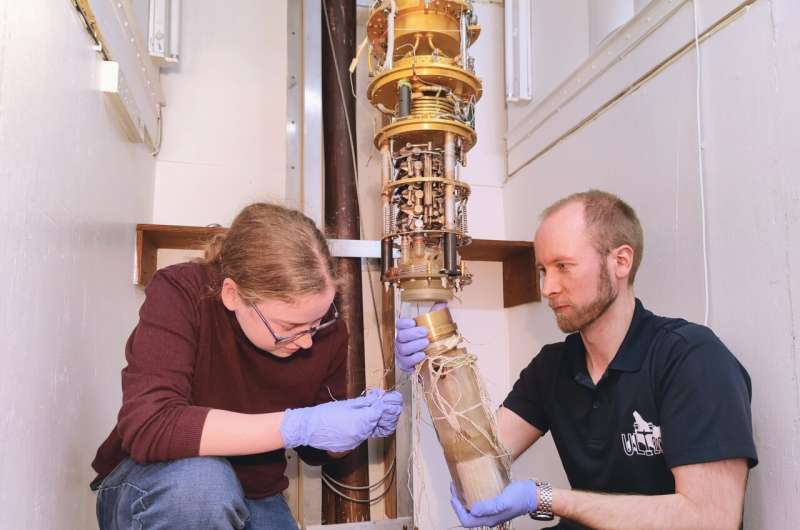
The experiment takes place at about a tenth of a degree above absolute zero in a special refrigerator; Dr. Autti (right). Credit: Lancaster University
One of science’s greatest mysteries may be about to be solved. About 80 percent of the matter in the universe is dark, meaning it’s invisible. In fact, dark matter is constantly passing through us, probably at a rate of several trillion particles per second.
We know it exists because we can see the effects of its gravity, but experiments so far have failed to detect it.
Leveraging the most advanced quantum technologies, scientists from Lancaster University, the University of Oxford and Royal Holloway, University of London are building the most sensitive dark matter detectors to date.
Their public exhibition, ‘A Quantum Vision of the Invisible Universe’, is on display at this year’s Royal Society’s flagship Summer Science Exhibition, from 2 to 7 July 2024. Related research is also published in Journal of Low Temperature Physics.
The researchers include Dr Michael Thompson, Professor Edward Laird, Dr Dmitry Zmeev and Dr Samuli Autti from Lancaster, Professor Jocelyn Monroe from Oxford and Professor Andrew Casey from RHUL.
Dr Autti, a member of the EPSRC, said: “We are using quantum technologies at ultra-low temperatures to build the most sensitive detectors to date. The aim is to observe this mysterious matter directly in the laboratory and solve one of the greatest puzzles in science.”
There is indirect observational evidence for the typical density of dark matter in the galaxy, but the mass of the constituent particles and their possible interactions with ordinary atoms are unknown.
Particle physics theory suggests two possible candidates for dark matter: new particles with interactions so weak that we have not yet observed them, and very light, wave-like particles called axions. The team is setting up two experiments, one to look for each.
Among both candidates, new particles with ultra-weak interactions could be detected by their collisions with ordinary matter. However, the ability to identify these collisions in an experiment depends on the mass of the dark matter being searched for. Most searches so far would detect dark matter particles weighing between five and a thousand times more than a hydrogen atom, but it is possible that much lighter dark matter candidates have been missed.
The QUEST-DMC (Quantum Enhanced Superfluid Technologies for Dark Matter and Cosmology) research team aims to achieve state-of-the-art sensitivity to collisions with dark matter candidates with masses between 0.01 and a few hydrogen atoms. To achieve this, the detector is made of superfluid helium-3, cooled to a macroscopic quantum state and instrumented with superconducting quantum amplifiers. The combination of these two quantum technologies creates the sensitivity needed to measure extremely weak signatures of dark matter collisions.
In contrast, if dark matter is made of axions, they would be extremely light—more than a billion times lighter than a hydrogen atom—but proportionally more abundant. Scientists would not be able to detect collisions with axions, but they could look for another signature—an electrical signal that occurs when axions decay in a magnetic field.
This effect can only be measured using an extremely sensitive amplifier, operating with the highest precision possible in quantum mechanics. The Quantum Sensors for the Hidden Sector (QSHS) team is therefore developing a new class of quantum amplifier that is perfectly suited to the search for an axion signal.
This year’s exhibition stand will allow visitors to observe the invisible through interactive and imaginative exhibits for all ages.
To show how we can infer dark matter from observing galaxies, we will see a gyroscope in a box that moves in surprising ways due to invisible angular momentum. We will also see transparent glass beads in a liquid, showing how invisible masses can be observed through clever experiments.
An illuminated dilution refrigerator will demonstrate how the team achieves ultralow temperatures, and a model of a dark matter particle collision detector will show how our universe would behave if dark matter behaved like normal matter.
Visitors can then search for dark matter with a model axion detector by scanning the frequency of a radio receiver, and they can also create their own parametric amplifier using a pendulum.
Carlos Frenk, cosmologist and Fellow of the Royal Society and Chair of the Public Engagement Committee, said: “Science is essential to helping us understand the world we live in, past, present and future. I invite visitors of all ages to come with an open mind, curiosity and enthusiasm and celebrate the incredible scientific achievements that benefit us all.”
More information:
S. Autti et al, QUEST-DMC: Background modeling and resulting heat deposition for a superfluid helium-3 bolometer, Journal of Low Temperature Physics (2024). DOI: 10.1007/s10909-024-03142-w
Provided by Lancaster University
Quote:Searching for dark matter with the world’s coldest quantum detectors (2024, July 4) retrieved July 4, 2024 from https://phys.org/news/2024-07-dark-coldest-quantum-detectors-world.html
This document is subject to copyright. Apart from any fair dealing for the purpose of private study or research, no part may be reproduced without written permission. The content is provided for informational purposes only.